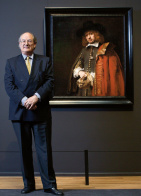Yesterday, at Rembrandt’s former home in Amsterdam, the exhibition “Rembrandt and Jan Six: the etching and the friendship” opened. It may be a small exhibition. It is an interesting one.
Jan Six belonged to a family which already had a long history, before they fled their native region. Their religion and the war between Spain and the Dutch Republic caused their flight. Jan Six’ parents settled in Amsterdam.
Commercial talents and wise marriages ensured, this refugee family became part of Amsterdam’s ruling class. The fascinating family history, covering the middle ages right up to the present, is told by Geert Mak in his absorbing book “De levens van Jan Six”; the lives of Jan Six.
 Lives? After Rembrandt’s friend Jan Six, family tradition ensured practically each eldest son was called Jan Six. In fact, Jan Six X initiated and collaborated on this exhibition.
Lives? After Rembrandt’s friend Jan Six, family tradition ensured practically each eldest son was called Jan Six. In fact, Jan Six X initiated and collaborated on this exhibition.
The exhibition starts with a small painting and large map. The map shows how close to each other Jan Six I and Rembrandt lived. Actually, Rembrandt’s clients, including Maerten and Oopjen, practically all lived “on his Amsterdam doorstep”.
Jan Six and Rembrandt were more than client and artist. One of the exhibits shows a stage drawing. Rembrandt drew it for one of Jan’s plays. Rembrandt also occurs in Jan’s Liber Amicorum – twice. The etching called “Bridge of Six” and the anecdote of its creation show, Rembrandt frequently visited Jan’s manor house outside Amsterdam.
 The exhibition’s highlight is Rembrandt’s etching of his friend. Rembrandt’s whole creative process can be followed step by step. Preliminary sketches and all but one of the trial prints are shown. The final result is one of Rembrandt’s finest, if not his best etching – created in this very house.
The exhibition’s highlight is Rembrandt’s etching of his friend. Rembrandt’s whole creative process can be followed step by step. Preliminary sketches and all but one of the trial prints are shown. The final result is one of Rembrandt’s finest, if not his best etching – created in this very house.
Unfortunately, the friendship ended. Jan married the daughter of influential, ambitious, straight-laced Nicolaes Tulp. Jan Six X and Geert Mak think the marriage and Tulp’s influence caused a breach.
Rembrandt’s life went from bad to worse. Jan’s already good life improved. He became one of Amsterdam’s many mayors, probably thanks to his father-in-law’s influence. Rembrandt died a pauper; wealthy Jan survived him.
Etchings by other artists show Jan as important burgher and mayor. Yet on his death, his widow was forced to settle debts by selling paintings and other belongings. Fortunately, the preliminary studies, etching, original copper plate remained in the family.
The masterwork was known by and inspired later, lesser artists. Visitors can admire a whole wall full of copies, as Jan Six X collects these. Guest curator Menno Jonker and museum staff ensured the exhibition contains works from the Six collection, the Amsterdam Museum and Amsterdam Rijksmuseum. The exhibition ends with the reappraisal of Rembrandt and rediscovery of his friendship with Jan Six, during the Romantic era.
“Rembrandt and Jan Six” can be visited in the museum’s modern part till the 3rd of September 2017.
The exhibition publication “Rembrandt and Jan Six”, is available in the museum shop.
Geert Mak’s fascinating family history is available in Dutch, German translation, while translations in Scandinavian and other languages is in progress. The English translation is expected to appear in September 2017.





